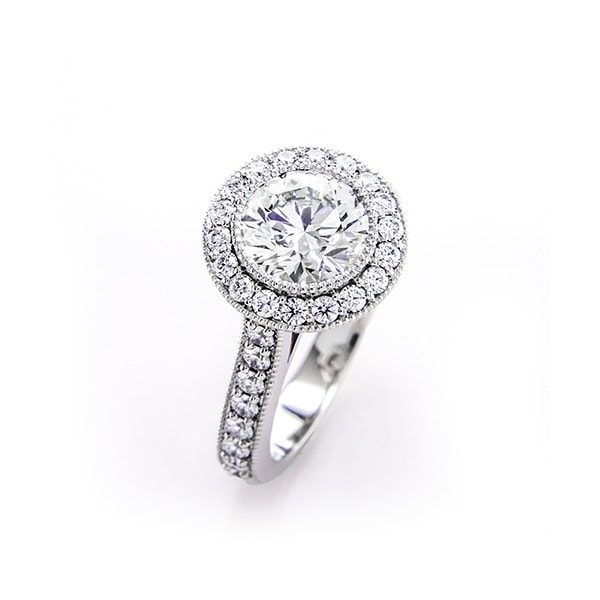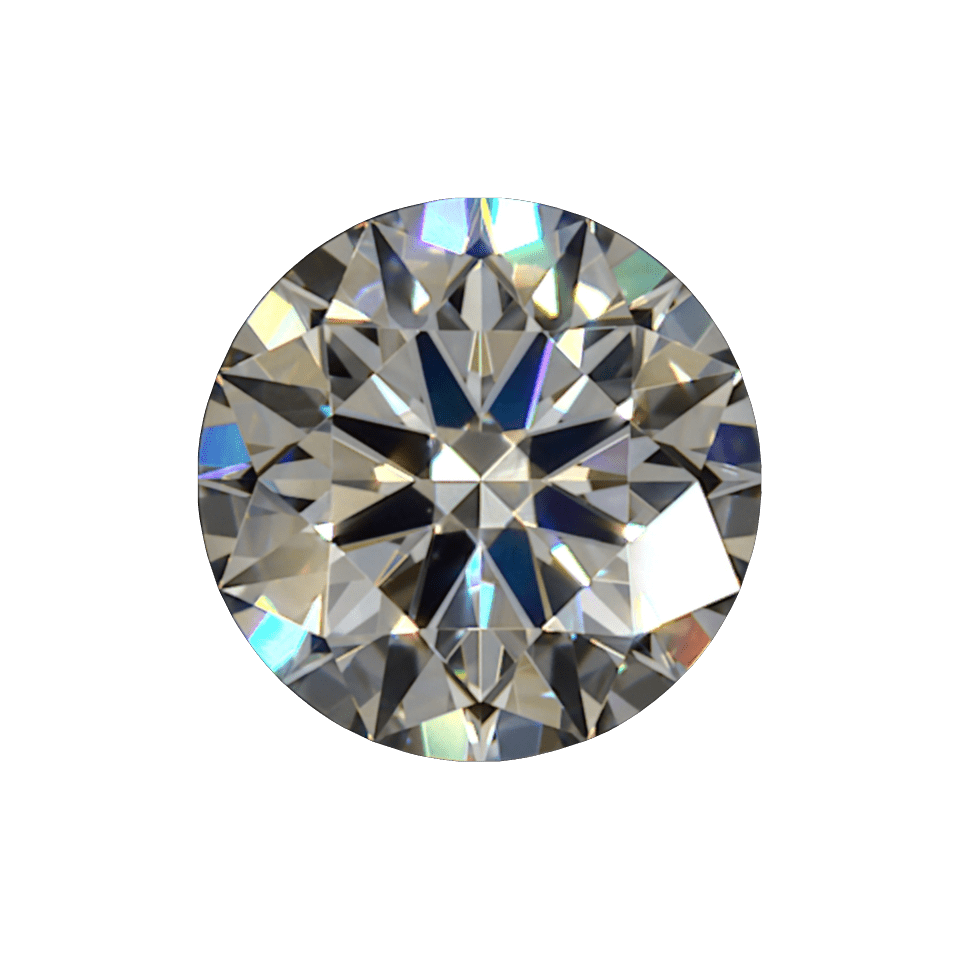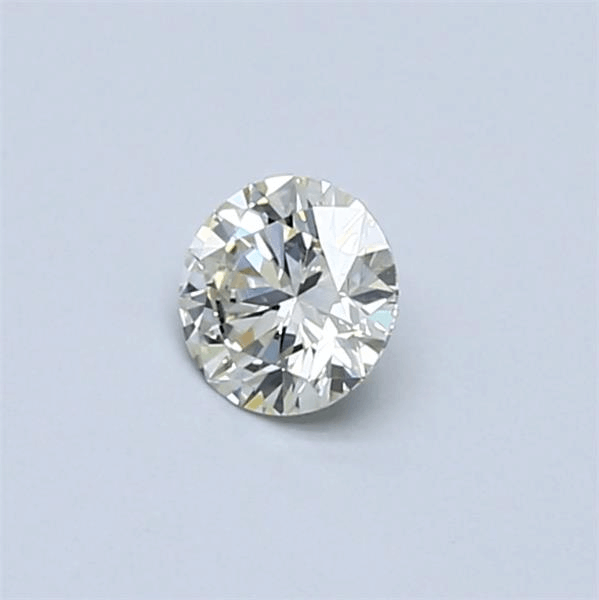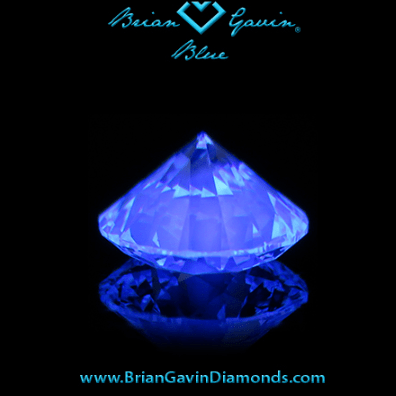
Table of Contents
When it comes to diamond fluorescence, there’s a lot of conflicting information going around. Some jewelers say to avoid it altogether, while others see it as an advantage.
So which is it?
There is no direct answer. Fluorescence can be both good and bad depending on the specific diamond and the type of fluorescence. There are several factors to consider when determining how fluorescence affects the price and quality of a diamond, but if carefully chosen, fluorescence can save you money and give you a stunning stone.
Having the right information about fluorescence can help you choose a stone to your advantage without getting ripped off. Let’s take a look.
What is Diamond Fluorescence?

Fluorescence refers to the colored glow that a diamond gives out when exposed to ultraviolet (UV) rays. It is the degree or intensity of the diamond’s reaction to these rays. This reaction can vary from very strong to none.
The GIA has a grading system which grades diamond fluorescence into the following categories:

Only about a third of diamonds are graded as having fluorescence, which means that roughly 60% of all diamonds fall into the ‘None’ category.
What Causes Diamond Fluorescence?
Pure diamonds with no trace elements is extremely rare. Diamonds often have some foreign elements that are absorbed during the formation process. If the element is one that reacts with UV light, such as boron, aluminum or nitrogen, then the diamond may show signs of fluorescence. If a diamond is fluorescent, it is because it contains one of these three elements.
How Does Fluorescence Affect Diamond Appearance?

Diamonds can fluoresce in a variety of colors but generally, the visible color manifested is blue. Other fluorescence colors, such as yellow, green and red can occur but are rare.
However, the point to note is that this colored glow will only be noticeable when the diamond is under UV light.
This begs the question:
Where will I come across UV light for my diamond to fluoresce? Some common sources of UV radiation include black lighting from night clubs, fluorescent bulbs, and even natural sunlight. This means that if a diamond with certain degrees of fluorescence is exposed to these sources of lights, it can give off a dull colored glow.
If there is no UV light source, it’s often difficult to tell that the diamond has fluorescence, especially for the Faint to Medium grades. Only a gemologist with special tools and a source of UV light would be able to determine the amount of fluorescence in the diamond.
Take a look at the four diamonds below all taken from the James Allen inventory:

At first glance, they all look very similar. The difference between the first three diamonds is barely perceptible. However, the diamond with strong fluorescence appears just a little hazy.
How Does Fluorescence Affect the Value of a Diamond?
The correlation between fluorescence and diamond value depends on the type of the diamond and the color of the fluorescence. Because this can get confusing, let’s break it down.
1. Blue Fluorescence and Diamond Value
For high quality diamonds of D-E-F color grades, fluorescence is seen as an imperfection and can bring the price of the stone down by up to 15%.
However, a cheaper diamond on the lower end of the color scale (I-M grades) with tints of yellow can appear a grade or two higher in color if the diamond contains blue fluorescence. This is because blue and yellow are complementary colors, and when blue fluoresce emits out of a yellow tinted diamond, it tends to neutralize the yellow tints, giving the stone a more colorless appearance. This can hike the price up slightly.
2. Yellow Fluorescence and Diamond Value
Now, when it comes to yellow fluorescence, you have the opposite effect as it makes the diamond look a grade or two lower in color. So for colorless diamonds, yellow fluorescence will add a yellowish look.
For diamonds with yellow tints, yellow fluorescence will make it appear even yellower, downgrading the quality of the stone further. This should be avoided as it will decrease the value of the diamond.
Having said that, bear in mind these changes are only noticeable as long as the stone is within a source of light that stimulates the fluorescence effect.
This is why, when buying a diamond, it is best to view the stone under different sources of light to see the color that it exhibits and whether or not this changes depending on the light source.
Does Fluorescence Cause Hazy Diamonds?

This depends on the level of fluorescence. Diamonds with Faint fluorescence never appear cloudy while those with Medium fluorescence may sometimes have a hazy appearance.
However, most diamonds with Strong and Very Strong blue fluorescence can appear cloudy even under normal lighting. The transparency of the diamond can be reduced, giving it an opaque, hazy appearance.
You may sometimes come across the term ‘overblues’. These are diamonds that have a very strong milky appearance to them. Because overblues are very rare, it’s uncommon to come across them on the market.
Many retailers don’t sell diamonds with very strong fluorescence. Although the GIA fluorescence scale goes up to Very Strong, many vendors like James Allen only offer diamonds with None to Strong fluorescence grades. Blue Nile, however, has diamonds with Very Strong fluorescence available on their website.
Should I Choose a Diamond With Fluorescence?
By now it’ll be clear that fluorescence can be used to your advantage (or disadvantage) when purchasing a diamond. You could opt for a high quality diamond that contains faint to medium fluorescence and pay less on the total price of the stone. Why pay more for a diamond that has no visible difference to a diamond with some fluorescence simply because it is ‘cleaner’?
Compare this .80 carat, D color, VVS1 clarity excellent round cut diamond with no fluorescence to this diamond with very similar specifications but with strong fluorescence. The diamonds look nearly identical, especially when seen at their original sizes. However, the difference in price is over $1000, which is considerable.
Apart from the price, diamonds with blue fluorescence can look stunning. The cool glowing appearance of the stone can make the diamond look beautiful. If chosen correctly, fluorescence is actually a benefit for your diamond.
But if you ask most retailers, they’ll tell you why fluorescence is bad and should be avoided. And why wouldn’t they? After all, it’s in their best interests if you pay more for a non-fluorescent diamond.
If you’re interested in buying a fluorescent diamond but aren’t sure how to pick the best, then we recommend checking out Brian Gavin’s Blue Collection.
Brian Gavin Blue Collection

The Brian Gavin Blue Collection offers diamonds that have fluorescence ranging from medium to very strong. Each diamond is carefully inspected by Brian Gavin himself to ensure that they are perfect, even though they have fluorescence.
The Blue Collection doesn’t contain diamonds that are hazy. Only the best diamonds are selected for this. Each diamond comes with a fluorescence image that indicates the intensity of the diamond’s fluorescence.
Brian Gavin Blue is a unique collection that celebrates diamond fluorescence, clearing up the misconception that fluorescence is always a bad thing for diamonds.
Where to Buy Fluorescent Diamonds?
When it comes to fluorescence, it’s important to see your diamond carefully prior to purchase. If the diamond you choose has faint to no fluorescence, it won’t be a factor to consider. If there is medium to very strong fluorescence, you would want to carefully check the diamond to ensure that it isn’t cloudy and has a beautiful, clear look.
Purchasing at a physical store allows you to carefully inspect the diamond and check it under different sources of light. You would be able to ask the jeweler to show you the diamond UV light. Most jewelers would be able to do this for you.
However, if you’re purchasing your diamond online, it can get tricky to ascertain whether or not fluorescence is affecting the appearance of the diamond. Most online retailers simply show a sample photo rather than the actual diamond. This is why it’s important to opt for a retailer with high quality videos, images and information about the diamond.

For this reason, we recommend James Allen and Brian Gavin for diamonds with fluorescence. James Allen provides ground breaking Diamond Display Technology, allowing you to carefully examine the magnified stone. You can also filter your diamond search to include diamonds with fluorescence.
The benefit of purchasing online is that the diamonds are almost always less expensive than diamonds in a physical store, and the quality is often higher as well. What’s more, you’ll have a lot of options to choose from.
Make sure that you receive a certificate of authenticity for the diamond from a reputable lab such as GIA, IGS or AGS and check for the specifications on fluorescence. You don’t want to be buying a fluorescent diamond for the price of a non-fluorescent one.
Read our reviews on James Allen and Brian Gavin for more information. Also check out our review where we compare online diamond retailers.
Wrapping Up
Fluorescence in a diamond is a complicated topic and one that generates a lot of misinformation. We recommend focusing more on how a diamond looks overall, rather than on whether or not it has fluorescence. By playing around with the diamond’s 4Cs and its fluorescence level, you can cherry pick a stone that is affordable while still looking amazing.









